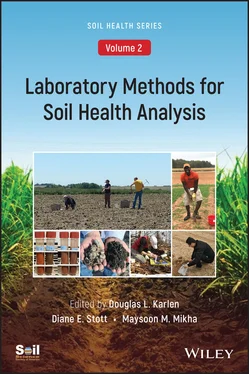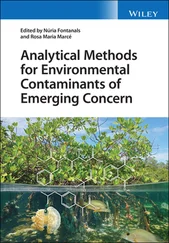Laboratory Methods for Soil Health Analysis, Volume 2
Здесь есть возможность читать онлайн «Laboratory Methods for Soil Health Analysis, Volume 2» — ознакомительный отрывок электронной книги совершенно бесплатно, а после прочтения отрывка купить полную версию. В некоторых случаях можно слушать аудио, скачать через торрент в формате fb2 и присутствует краткое содержание. Жанр: unrecognised, на английском языке. Описание произведения, (предисловие) а так же отзывы посетителей доступны на портале библиотеки ЛибКат.
- Название:Laboratory Methods for Soil Health Analysis, Volume 2
- Автор:
- Жанр:
- Год:неизвестен
- ISBN:нет данных
- Рейтинг книги:3 / 5. Голосов: 1
-
Избранное:Добавить в избранное
- Отзывы:
-
Ваша оценка:
- 60
- 1
- 2
- 3
- 4
- 5
Laboratory Methods for Soil Health Analysis, Volume 2: краткое содержание, описание и аннотация
Предлагаем к чтению аннотацию, описание, краткое содержание или предисловие (зависит от того, что написал сам автор книги «Laboratory Methods for Soil Health Analysis, Volume 2»). Если вы не нашли необходимую информацию о книге — напишите в комментариях, мы постараемся отыскать её.
Analyzing, comparing, and understanding soil health data Soil Health, Volume Two: Laboratory Methods for Soil Health Analysis
Laboratory Methods for Soil Health Analysis, Volume 2 — читать онлайн ознакомительный отрывок
Ниже представлен текст книги, разбитый по страницам. Система сохранения места последней прочитанной страницы, позволяет с удобством читать онлайн бесплатно книгу «Laboratory Methods for Soil Health Analysis, Volume 2», без необходимости каждый раз заново искать на чём Вы остановились. Поставьте закладку, и сможете в любой момент перейти на страницу, на которой закончили чтение.
Интервал:
Закладка:
Collection of metadata (Vol. 1, Chapter 4) is an important part of site characterization and will facilitate interpretation of measurements. At a minimum, geographical, landscape, soil, vegetation, climatic, and management attributes should be recorded and maintained for future reference ( Table 2.2). When sampling as part of a long‐term study, more metadata is required to accurately characterize each sampling site (see Table 1.2in Boone et al., 1999).
Table 2.2 Suggested minimum metadata for site characterization.
| Category | Metadata |
|---|---|
| Geography | Site identifier/nameState/Province, county, city, postal codeLatitude, longitude, and elevationRegional characterization (e.g., Farm Resource Region, Hydrologic Unit Code, Major Land Resource Area) |
| Landscape, Soil, and Vegetation | Landscape position, slope, and aspectSoil series and taxonomic descriptionNative vegetation |
| Climate and Weather | Mean annual temperatureMean annual precipitationLength of frost‐free period |
| Management | Current managementManagement history |
Sampling Designs
Following preliminary site characterization, the evaluator must decide how to sample the site. The design used for sampling should reflect the goals of the evaluator, recognizing and reconciling tradeoffs associated with different designs ( Table 2.3). Typically, available time and resources dictate the selection of a sampling design.
Judgement Sampling
Judgement sampling selects sites presumed to represent larger areas ( Table 2.3). Since site selection is based on the evaluator’s knowledge and skill, it is subject to considerable bias. As outcomes are inherent to the evaluator, application of this design for long‐term use is limited as changes in evaluator judgement are possible over time. Data collected using judgement sampling has limited statistical validity especially when isolated from other sites sampled by the same evaluator.
Despite its drawbacks, judgement sampling can be useful when resources are scarce and demands for accuracy and statistical rigor are relaxed. This design may also be applicable when samples are difficult to collect, or an evaluation involves attributes with high analytical cost.
Table 2.3 Definitions and attributes of different soil sampling designs.
| Description | Advantages | Disadvantages | Potential application |
|---|---|---|---|
| Judgement sampling | |||
| An approach to sampling that bases site selection on the knowledge and skill of the evaluator. Effective use of approach requires prior knowledge of site and attributes being assessed. Sites are generally selected to avoid nonrepresentative locations with the larger area. | Uses expert knowledge of site.Sampling decisions informed by previous experience.Limited sampling can save time and resources. | High degree of evaluator bias. Outcomes strongly associated with the individual doing site selection.Samplings over time are compromised by changes in evaluator judgement.Limited application to statistical analyses.Less legally defensible. | Initial site screening when resources for sampling and analyses are limited and demands for accuracy and statistical rigor are relaxed.In some instances, this approach may be useful for the evaluation of very expensive attributes when only a restricted number of samples can be collected. |
| Simple random sampling | |||
| A sampling approach whereby each sample collected has an equal chance of being selected. If used, prior knowledge of site is not required. | Approach minimizes bias associated with site selection.Relatively easy to apply.Approach is statistically valid. | Approach treats all points as equally important regardless of inherent and/or management‐induced stratification.Sampling locations may not adequately represent entire site (e.g., clustered sampling locations limit information on spatial distribution). | Approach is useful when knowledge of the site is limited.Collected data may be amenable to modeling applications (e.g., sensitivity analysis). |
| Stratified random sampling | |||
| An approach that uses random sampling within unique subareas to characterize a site. Prior knowledge of site stratification is helpful for identification of subareas. | Acknowledges intra‐site differences in inherent soil and/or management attributes. Accordingly, there is increased sensitivity to site nuances.Approach may increase sampling efficiency.Allows for understanding of presumed sources of site variability. | Approach requires prior knowledge of site attributes.Requires a more complex data analysis.Delineation of site by stratified attribute can differ among evaluators.Approach may generate many samples, requiring more resources. | Useful at sites with apparent soil, landscape, management, and/or contamination zones. |
| Systematic sampling | |||
| An approach to sampling whereby an entire area is sampled at predetermined points, usually in a grid‐like pattern. If used, prior knowledge of site is not required. | Application of sampling approach is generally straightforward.Can return to the same location for future samplings with confidence.Approach allows for use of geostatistical data analyses. | Selection of grid size can bias outcomes.Limited application of evaluator judgement.Approach may sacrifice sampling efficiency for the sake of following an established pattern.Depending on site, approach may be less cost effective than others. | Useful for soil mapping purposes when knowledge of site is limited.Appropriate in situations where the variable of interest is not expensive to collect and analyze.Collected data may be amenable to modeling applications (e.g., sensitivity analysis). |
Simple Random Sampling
The simple random sampling design assumes each given area has an equal opportunity of being selected ( Table 2.3), and this typically involves pre‐selection of sampling points to avoid evaluator bias (Dick et al., 1996). Point selection may be done using a random number table and a coordinate grid overlain on an image of the sampling area, or with a random point generator and GIS (geographic information systems) software package (e.g., ArcGIS). Use of this sampling design minimizes bias associated with point selection.
Though easy to apply, simple random sampling has notable caveats since all points in an area are assumed to have equal importance, regardless of variation in inherent features and/or spatial stratification of management attributes. Spatial distribution of selected points therefore may not adequately represent an entire site, although this concern diminishes as the number of sample points increases. This design may be appropriate when knowledge of the site is limited.
Stratified Random Sampling
Stratified random sampling applies simple random sampling to preselected subareas of a site ( Table 2.3). This design requires knowledge of site characteristics to accurately identify the location, extent, and boundary of subareas. This sampling design is most useful at sites with clearly defined soil, landscape, management, and/or contamination zones (Dick et al., 1996).
Assessing soil health indicators within defined subareas will provide a more complete understanding of inherent and/or management‐induced variation. The drawback of this sampling design is a corollary to its strength, since subarea stratification will require more resources than simple random sampling.
Systematic Sampling
Интервал:
Закладка:
Похожие книги на «Laboratory Methods for Soil Health Analysis, Volume 2»
Представляем Вашему вниманию похожие книги на «Laboratory Methods for Soil Health Analysis, Volume 2» списком для выбора. Мы отобрали схожую по названию и смыслу литературу в надежде предоставить читателям больше вариантов отыскать новые, интересные, ещё непрочитанные произведения.
Обсуждение, отзывы о книге «Laboratory Methods for Soil Health Analysis, Volume 2» и просто собственные мнения читателей. Оставьте ваши комментарии, напишите, что Вы думаете о произведении, его смысле или главных героях. Укажите что конкретно понравилось, а что нет, и почему Вы так считаете.












